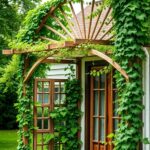Landscaping a hillside can be a fun challenge, turning uneven terrain into a captivating outdoor space. With a little creativity and some clever design ideas, you can transform that slope into a beautiful retreat. Here are 17 hillside landscaping ideas to inspire your next project and help you make the most of your unique landscape.
Native Plant Landscaping for Sustainability

When it comes to hillside landscaping, using native plants is a smart choice. Native plants are adapted to the local climate and soil, which means they require less water and maintenance. This not only saves you time but also benefits the environment.
The image shows a vibrant yellow flower standing tall amidst a backdrop of green trees and rocky terrain. This flower is likely a native species, thriving in its natural habitat. By incorporating such plants into your landscape, you enhance biodiversity and provide habitats for local wildlife.
Choosing native plants also encourages sustainability. They help prevent soil erosion, especially on slopes, and reduce the need for chemical fertilizers and pesticides. This leads to a healthier ecosystem overall.
Incorporating native landscaping principles allows your hillside to flourish naturally. Imagine a serene landscape filled with plants that bloom in harmony with the seasons. Plus, you’ll enjoy less maintenance and more time to relax in your beautiful outdoor space.
Wildflower Patches for Colorful Hillsides

Wildflower patches can truly brighten up any hillside. Imagine rolling hills adorned with vibrant blooms, creating a natural masterpiece. The beauty of wildflowers lies in their variety and resilience. They come in different colors and sizes, all working together to create a stunning visual effect.
Planting wildflowers is not only about aesthetics. These flowers attract pollinators, such as bees and butterflies, which are vital for our ecosystem. By adding wildflower patches to your landscape, you’re also supporting local wildlife. It’s like throwing a party for nature right in your backyard!
When designing your hillside, think about layering different species of wildflowers. This can create depth and texture. Consider using native species, as they are well-suited to your local climate and soil conditions. Plus, they often require less maintenance, freeing up your time to enjoy the view.
Another fun idea is to mix in some pathways or seating areas among the flowers. This way, you can enjoy the scenery up close. Whether it’s a small bench to relax or a winding path to wander, these elements can enhance your wildflower patch and make your hillside even more inviting.
Pathway Design with Natural Materials

Creating a pathway in your hillside landscape can be both functional and visually appealing. The image showcases a lovely stone path that winds through vibrant greenery and blooming flowers.
Using natural materials like stone helps blend the pathway seamlessly into the landscape. The uneven shapes of the stones add character while maintaining a rustic charm. This type of pathway invites you to explore the garden at your own pace.
Alongside the path, colorful flowers dot the landscape, enhancing the beauty of the journey. Flowers like yellow daffodils and red begonias pop against the green grass, making the path feel alive and welcoming. Incorporating such flowers not only brings a splash of color but encourages biodiversity.
Consider adding similar pathways in your garden. They can lead to seating areas, garden beds, or simply meander through your landscaping. Whether you choose large flat stones or smaller pebbles, the key is to ensure they feel natural in your environment.
Raised Bed Vegetable Gardens on Slopes

Raised bed vegetable gardens are excellent for slopes, providing an organized and accessible way to grow your own food. In the image, you can see neatly arranged wooden raised beds filled with a variety of vegetables. This setup not only looks appealing but also maximizes your growing space on a hillside.
Using raised beds on slopes helps with drainage and can prevent soil erosion. The tiered design allows for easy maintenance, making it simpler to reach plants without having to navigate uneven ground. You can grow a range of vegetables, like tomatoes, lettuce, and radishes, all while enjoying the beauty of your landscape.
Consider adding pathways between the beds for easy access. This makes it convenient to care for your plants and harvest produce. Plus, it enhances the overall design of your garden, making it a lovely spot to relax and enjoy nature. Whether you’re a seasoned gardener or just starting, raised beds on slopes can be a practical and attractive solution for your hillside gardening needs.
Stone Steps Leading to a Scenic View

Stone steps can transform a hillside into a welcoming path that leads to breathtaking views. These steps not only provide a functional way to navigate elevation changes, but they also create an inviting atmosphere. The natural texture of the stones blends beautifully with the surrounding greenery, enhancing the overall feel of the landscape.
As you walk down the winding path, you can enjoy the sights and sounds of nature. The gentle curve of the steps encourages a leisurely stroll, allowing for moments of reflection. Along the way, you might notice various plants and trees that add character to the scene.
These stone steps are not just about utility; they also serve as a focal point in your landscaping. They can draw the eye upward to the stunning panoramic views at the top. Whether you’re taking a morning jog or a peaceful evening walk, this setting feels like a little slice of paradise.
Boulder Accents in a Natural Landscape

When it comes to hillside landscaping, incorporating boulders can add a touch of natural beauty and a sense of stability to your garden. The image showcases a sloping area filled with large, smooth boulders nestled among vibrant greenery and colorful flowers.
Using boulders as accents can create a visually appealing contrast against the surrounding plants. The natural shapes and textures of the rocks work harmoniously with the soft edges of the foliage. This combination enhances the overall landscape, making it feel both inviting and rustic.
Moreover, these boulders can serve practical purposes, such as preventing soil erosion on slopes. They also provide a habitat for various wildlife, contributing to the ecosystem of your garden. Planting low-growing shrubs and flowers around the boulders can soften the hard edges, making the area more approachable.
One effective approach is to use a variety of rock sizes and shapes. This diversity creates interest and mimics how boulders are found in nature. Consider pairing the boulders with native plants, which thrive in the local climate and require less maintenance.
Terraced Gardens for Erosion Control

When it comes to hillside landscaping, terraced gardens are a smart choice for both aesthetics and functionality. This style allows you to break up large slopes into smaller, manageable sections, which can greatly reduce soil erosion. The image above beautifully illustrates this concept, featuring a series of lush terraces adorned with colorful flowers and greenery.
Each tier of the garden serves as a natural barrier, holding soil in place and preventing it from washing away during heavy rain. The use of planting beds not only adds beauty but also promotes healthier plant growth. This is because the terraces can capture rainwater and enable better drainage.
Incorporating various plant types enhances the visual appeal while providing a habitat for local wildlife. The mix of flowers, shrubs, and ground cover creates a vibrant display that changes with the seasons.
Additionally, adding stone steps or pathways, like those seen in the image, makes it easier to access each level of the garden. This promotes maintenance and allows you to enjoy your garden fully. So, if you’re looking to beautify your hillside while controlling erosion, consider creating a terraced garden.
Water Features to Enhance Hilltop Serenity

When it comes to hillside landscaping, adding water features can really elevate the tranquil vibe. Just picture a beautiful fountain, like the one in this image, sitting gracefully among vibrant flowers and lush greenery. Water features not only catch the eye but also create soothing sounds that bring a sense of calm to your space. Imagine the gentle splash of water as it cascades down and the way it reflects the surrounding landscape. It’s a delightful addition that draws you in and makes you want to linger a little longer.
In this serene setting, the fountain becomes a focal point, surrounded by carefully arranged plants and flowers. The rocks used to frame the water add a natural touch, blending beautifully with the hillside. Incorporating a variety of textures and colors enhances the overall appeal. You might even consider adding benches nearby, so you can enjoy the view while listening to the soft gurgle of the fountain. This kind of space invites relaxation and can be a perfect spot for morning coffee or evening chats with friends.
Seating Areas with Scenic Backdrops

Creating a cozy seating area on a hillside offers a perfect blend of comfort and nature. This image showcases a lovely setup with plush chairs and a small table, all framed by a breathtaking view of rolling hills.
The inviting chairs are perfect for lounging, whether you’re sipping coffee in the morning or enjoying a glass of wine in the evening. The open space allows you to soak in the beauty of the landscape, making every moment feel special.
Consider incorporating elements like soft cushions and a fire pit to enhance the warmth of your seating area. Adding plants or flowers around the space can also add a pop of color while blending seamlessly with the natural surroundings.
Choosing a location with a clear view ensures that your seating area is not just functional but also a delightful retreat. It invites you to relax and appreciate the beauty of the outdoors, creating a serene spot for gatherings or quiet reflection.
Fire Pit Oasis for Gatherings

Picture this: a cozy fire pit surrounded by inviting chairs, perfect for evening gatherings. The scene is set in a hillside landscape, where you can enjoy both the warmth of the fire and the beauty of nature. The soft glow of string lights adds a touch of charm as night falls, casting a warm ambiance over the area.
This fire pit oasis is not just a spot for roasting marshmallows; it’s a gathering place for friends and family. The setting encourages conversation, laughter, and memories under the stars. With comfortable seating arranged in a circle, everyone feels included. You can easily imagine sharing stories or singing along to your favorite tunes.
Adding a fire pit to your hillside landscaping transforms the space into a welcoming retreat. Whether it’s a chilly evening or a summer night, the fire offers warmth and a focal point for your outdoor activities. It’s a simple addition that invites connection and relaxation, making it a valuable feature in your landscape design.
Hiking Trails to Explore the Landscape

Hillside landscapes offer unique hiking trails that invite exploration. The image showcases a winding path that meanders through lush greenery and vibrant wildflowers. This trail appears perfect for a leisurely stroll or a more adventurous hike. The sunlight filtering through the trees creates a warm, inviting atmosphere.
As you walk along this path, you can enjoy breathtaking views of the surrounding mountains and valleys. The diverse plant life along the trail adds a splash of color and enhances the natural beauty of the area. It’s a great spot to take a break, breathe in the fresh air, and soak in your surroundings.
Consider packing a small backpack with snacks and water, as well as a camera to capture the stunning scenery. Whether you’re hiking solo or with friends, these trails provide a wonderful opportunity to reconnect with nature and enjoy a bit of tranquility away from the hustle and bustle.
Dry Creek Beds for Drainage Solutions

When landscaping a hillside, one effective solution for managing water runoff is to create dry creek beds. These natural-looking features not only enhance the aesthetic appeal of your yard but also serve a practical purpose. By directing water flow and preventing erosion, dry creek beds help maintain the integrity of your landscaping.
As shown in the image, the dry creek bed is lined with a variety of stones and pebbles. This design allows rainwater to flow smoothly through the yard while filtering it naturally. The choice of rocks can vary, giving you the freedom to match the creek bed with your overall landscape design.
In addition to their functional benefits, dry creek beds can be integrated with native plants and shrubs. This not only stabilizes the soil but also adds life and color to your hillside. Consider planting hardy, drought-resistant plants around the creek bed to enhance its appearance even further.
Overall, dry creek beds are a smart, stylish option for managing hillside drainage. They combine form with function, creating a landscape feature that is both beautiful and practical.
Vertical Gardening on Steep Slopes

Vertical gardening is a smart and stylish way to tackle steep slopes and maximize your green space. The image shows a stunning vertical garden that utilizes a wall to create a lush, inviting atmosphere. This design not only adds beauty but also helps prevent soil erosion. Many plants cascade down the structure, offering layers of greenery that are pleasing to the eye.
When you have a hillside, using vertical gardening can be a game plan. It allows you to grow various plants without taking up too much ground space. You can add different types of plants, from colorful flowers to robust vines. This diversity adds texture and interest to your landscape.
Another plus is the ease of maintenance. Vertical gardens can be simpler to care for since they are often more accessible than traditional gardens. You can water them without bending over too much and can easily spot any issues with pests or diseases.
For anyone looking to enhance their hillside, consider creating a vertical garden. It’s a fun project that not only beautifies your space but also offers practical benefits. So gather your favorite plants and start your vertical journey!
Fencing with Natural Materials for Privacy

When it comes to hillside landscaping, using natural materials for fencing can add both privacy and charm to your space. The image showcases a lovely wooden fence that blends seamlessly with its surroundings. It not only provides a boundary but also enhances the rustic feel of the garden.
The gentle curve of the fence complements the natural landscape, making it feel integrated rather than intrusive. This type of fencing can be an excellent choice for anyone looking to create a cozy nook in a hillside garden.
Incorporating flowering plants and lush greenery at the base of the fence adds to the aesthetic appeal. The vibrant colors of the flowers contrast beautifully with the earthy tones of the wood, creating a lively and inviting atmosphere. It’s all about creating a harmonious look that encourages relaxation and enjoyment of your outdoor space.
If you’re considering natural fencing, think about the materials that will hold up well in your climate. Wood is a popular option, but you can also explore bamboo or stone. Each choice has its unique benefits and can provide the privacy you desire while maintaining a natural vibe.
Sustainable Mulching Techniques

Mulching is a key part of hillside landscaping, and the image shows a beautiful example of how it can be used effectively. The area is covered with natural mulch, which complements the green plants peeking through. This method not only looks appealing but also serves multiple purposes.
Using organic mulch, such as wood chips or bark, helps improve soil health. As it breaks down, it adds nutrients to the soil, giving your plants a boost. You can see how the mulch in the image creates a neat and tidy appearance while providing a cozy environment for the plants.
Additionally, mulch acts as a moisture barrier. It helps retain soil moisture, which is crucial for hillside gardens where rainwater might run off quickly. This means your plants won’t struggle as much during dry spells.
Another benefit of mulching is weed suppression. By covering the ground, it reduces the chance of weeds taking hold. This makes maintenance easier and lets you focus on enjoying your landscape.
Overall, sustainable mulching techniques not only enhance the beauty of your hillside but also promote a healthier garden ecosystem. With the right approach, you can create a vibrant and sustainable outdoor space.



